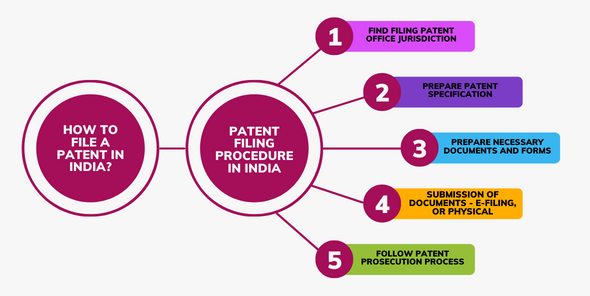Patent Filing Procedure in India
As India is slowly moving toward becoming an innovation hub in Asia, patent filing has suddenly gained momentum. Indian government’s initiatives to encourage innovators and startups are also playing a pivotal role, eventually leading to increased interest in filing patents in India.
Innovators and Startups are keen to get their innovations patented to safeguard them from infringements and potential market competitors and further enjoy monopolistic and exclusive business gains. It has led to an increase in awareness of patent filing.
A patent application can be filed at the Indian Patent Office or through E-filing [online filing of patents].
This article will discuss the procedure and process for filing a patent in India and also provide a gist of how to file a patent in India.
Who can file a Patent Application?
The application can be filed either alone or jointly:
*By any person claiming to be the true and first inventor(s)
*By any person being the assignees of a person claiming to be the true and first inventor(s)[proof of assignment has to be submitted with the application] * By the legal representative of any deceased person or assignee
Where to File a Patent Application?
1. Physical filing: You can apply for any one of the Indian patent offices, which are located in Chennai, Delhi, Mumbai, or Kolkata, at the counter of the jurisdictional patent office.
The Patent application can be submitted at the appropriate patent office and is determined based on the applicant’s region/location-
i) where the applicant resides; or
ii) has a place of business, or
iii) the place from where the invention originated.
For the applicant, who is non-resident or has no residence or has no place of business in India, the address for service in India or place of business of his patent agent determines the appropriate patent office where applications for a patent can be filed. Suppose, as an applicant, you do not have a place of residence, domicile, or place of business in India. Accordingly, the place for filing your application will depend on the address you have furnished for the service. For example, patent applications are submitted at the Chennai Patent Office when the address for services is Intepat, Bangalore.
It is important to note that, ordinarily, once the appropriate office has been decided, it cannot be changed.
| Office | Territorial jurisdiction |
| Patent Office Branch, Mumbai | The States of Maharashtra, Gujarat, Madhya Pradesh, Goa, and Chhattisgarh and the Union Territories of Daman and Diu & Dadra and Nagar Haveli |
| Patent Office Branch, Chennai | The States of Andhra Pradesh, Karnataka, Kerala, Tamil Nadu, and the Union Territories of Pondicherry and Lakshadweep, Telangana |
| Patent Office Branch, New Delhi | The States of Haryana, Himachal Pradesh, Jammu and Kashmir, Punjab, Rajasthan, Uttar Pradesh, Uttarakhand, Delhi, and the Union Territory of Chandigarh. |
| Patent Office Kolkata | Rest of India |
2. E-filing: this can be done using the e-filing portal of the patent office.
Physical Documents for applying at Indian Patent Office:
1) Form-1: Application for grant of a patent [in duplicate];
2) Form-2: Provisional or complete specification. If the provisional specification is filed, it must be followed by the complete specification within 12 months [in duplicate];
3) Drawings (if necessary) [in duplicate];
4) Form-3: Statement and undertaking for the corresponding foreign patent applications [in duplicate];
5) Form-5 Declaration of inventorship: This is submitted either with the provisional specification followed by the complete specification or, in the case of convention/PCT national phase applications [in duplicate];
6) Form-9: Request for early publication (optional) [in duplicate];
7) Form-18: Request for examination (optional) [in duplicate];
8) Form-26: A power of attorney (if filed through a Patent Agent) [Form-26];
9) statutory patent fees – DD/Cheque; and
10)A certified copy of the priority document (In case priority is claimed). Priority documents must be filed in the following cases:
-Convention application (under Paris Convention);
-PCT National Phase application wherein requirements of Rule 17.1(a or b) has not been fulfilled
-Priority documents must be filed along with the application or before the expiry of 18 months from the date of priority to enable the early publication of the application.
Documents required for E-filing:
i) Pre-requisites:
-Login ID and password;
-Digital signature; and
-Valid debit/credit/net banking facility
ii) All the necessary physical documents mentioned above in PDF format;
iii) Statutory fee via the payment gateway.
Hard copies of the requested documents duly signed by the applicant/agent should be sent to the jurisdictional patent office if requested by the controller.
Patent Applications Types:
a) Ordinary Application (Normally, filed for an application without claiming priority)
b) Application for Patent of Addition (allowed for improvement or modification of the parent patent application)
c) Divisional application (in case of a plurality of inventions disclosed in the main application).
d) Convention Application, claiming priority date based on filing in convention countries.
e) National Phase Application under PCT.
Patent Process in India
The patent process in India or patent prosecution refers to the entire process of obtaining a patent grant. It involves the interaction between the Assignee/Inventor or Patent Agent and Patent Office concerning the patent application.
A patent application has to pass through various steps during the patent prosecution process. These steps shall be discussed below for our readers’ basic understanding and answers to the questions of how to apply for a patent in India.
Process of Patent Registration in India:
Step 1: Filing A Patent Application
As explained above, patent documents can be filed either online or at the patent office in respective jurisdictions: Kolkata, Delhi, Mumbai, and Chennai.
Basic types of applications:
Provisional application: Inventors usually opt for provisional application when their idea is in the research and development stage. The specification document contains a simple description of the invention. However, the inventor should file the complete patent specification document within 12 months of submitting the provisional application.
Complete application: When an inventor has the complete invention while applying for a patent, he can file a complete application. Chapter III, Section 10 of the Indian Patent Act, outlines the structure of the specification document.
Fee:
| Natural Person
(INR) |
Small Entity/Startup
(INR) |
Large Entity
(INR) |
|
| Physical Filing | 1750 | 1750 | 8800 |
| E-Filing | 1600 | 1600 | 8000 |
Step 2: Publication
The patent office publishes the application 18 months from the filing date or priority date in the patent journal. This publication is automatic and does not require any intervention from the applicant. However, the applicant can request an early publication through Form 9. In such cases, usually, the Office publishes the patent within a month of requesting it.
Fees:
| Natural Person
(INR) |
Small Entity/Startup
(INR) |
Large Entity
(INR) |
|
| Physical Filing | 2750 | 2750 | 13750 |
| E-Filing | 2500 | 2500 | 12500 |
Step 3: Request for Examination (RFE)
After filing a patent application, the applicant needs to submit an examination request. We can file this request through Form 18, and the controller will transfer the application to the patent examiner for further examination. Generally, the applicant should submit the request for examination within 48 months of filing the application or priority date. Moreover, this deadline is crucial because if we do not file a request for examination within the time limit, the Office will consider the application withdrawn.
And also, an expedited examination is another provision provided.
Step 4:Patent Examination
The Controller will transfer the application to the examiner within one month of the request for examination. Firstly, the patent examiner will thoroughly examine the patent and ensure that the invention is patentable and complies with The Patent Act. Furthermore, the examiner will issue the First Examination Report (FER) to the applicant or authorized agent within two months of receiving the file.
The examiner may raise objections regarding the patent application in the FER report. The FER generally includes a summary of the report, a detailed technical report with a list of cited documents for novelty, inventive steps, and other formal requirements. These days the examination reports are issued by email, and where no email is available, the examination report shall be dispatched by post.
The applicant should respond to these objections within six months of the report. Likewise, some guidelines for responding to a First Examination Report can be found in the article procedure to file a response. However, the applicant can also request an extension to respond to the objections for three months via Form 4. Meanwhile, if the applicant fails to respond within the stipulated time, the Indian Patent Office will consider the application abandoned.
Step 5: Examination Response
Once the patent application examination is conducted, and objections are generated in the FER, the applicant is expected to respond to the objection present within six months from the date of the examination report.
The FER may also contain some objections under Sec 9, 10, 57, and 59 of the Patents Act, 1970, which lists the format-related requirements of the specification, drawings, and other enclosures of the Patent Application. These need to be addressed as well.
Incorrect, delayed, or improper response to the FER can prove detrimental to your patent application. Therefore, it is imperative to address all the objections accurately to ensure a quick patent grant.
The applicant can amend the claims to overcome the objection.
Step 6: Grant of Patent
Finally, once the patent application overcomes all the objections, the patent office grants the patent and publishes it in the patent gazette. The patent office issues intimation concerning the acceptance of the application. Within seven days of approval, a grant certificate is issued via email.
Step 7: Renewal of patent
The renewal fee shall be payable at the expiration of the second year from the date of the patent or any succeeding year to keep the patent in force. You can find further details concerning the patent renewal and fees applicable here.
Opposition (Optional)
As soon as the publication of the patent application and the filing of the request for examination is complete, any third party can file a pre-grant opposition. In comparison, only an interested party can file a post-grant opposition within 12 months of the granting of the patent. An interested party refers to any company in a similar field of business.
Firstly, an Opposition Board receives the objections and evidence from the third party. It carefully scrutinizes the evidence from the opposition and the patent holder’s response to the opposition. Then, it submits its recommendation to the Controller. Usually, the patent office decides to maintain, amend, or revoke the patent via a hearing. It ensures that the patent cannot proceed with the grant unless the opposition is set aside.
Further, you can find more details on the opposition and its various aspects here.
There is no fee chargeable by the patent office on filing the pre-grant opposition, whereas the below-mentioned provides fee particulars for filing the post-grant opposition:
| Natural Person
(INR) |
Small Entity/Startup
(INR) |
Large Entity
(INR) |
|
| Physical Filing | 2600 | 2600 | 13200 |
| E-Filing | 2400 | 2400 | 12000 |
Therefore, the above essential points must be noted while filing a patent application in India.
The process and procedure of obtaining a patent are very systematic and scheduled; hence, it is inevitable to meet the deadlines to avoid complications. One can always seek the help and guidance of a patent attorney to navigate the patenting process easier.




